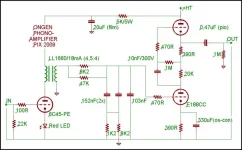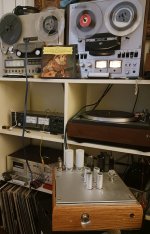Elevated heater potential is commonly advised when stacked tubes, such as a mu-follower, is used.
But let’s say I have 320V at B+ and will use a 6DJ8 in a mu-follower topology. 100V at the bottom tube anode, 120V over its anode load and 100V over the topp tube. That will put respective cathodes a couple of volts above gnd respective 220V.
Elevating the heater to 100V from gnd will put it -120V below the topp tube which is at the limit for a 6DJ8 (U+k-f).
But from what I understand the limit is harder for the bottom tube cathode to heater (U-k/+f), stating only +60V.
Have I misunderstand the specs or is the limitation of heater elevation for 6DJ8 actually 60V, setting a limit for the top tube catode at 180V (60+120).?
But let’s say I have 320V at B+ and will use a 6DJ8 in a mu-follower topology. 100V at the bottom tube anode, 120V over its anode load and 100V over the topp tube. That will put respective cathodes a couple of volts above gnd respective 220V.
Elevating the heater to 100V from gnd will put it -120V below the topp tube which is at the limit for a 6DJ8 (U+k-f).
But from what I understand the limit is harder for the bottom tube cathode to heater (U-k/+f), stating only +60V.
Have I misunderstand the specs or is the limitation of heater elevation for 6DJ8 actually 60V, setting a limit for the top tube catode at 180V (60+120).?
The stated limit is the stated limit; 60 +120. Whether you want to violate that limit is up to you. It's not clear how manufacturers actually determined the limit, or whether they considered it a 'hard' safety limit or a 'soft' performance limit. Philips quoted it as 50V & 150V, RCA quoted 200V for both sections, etc. Was there really a difference in the tubes or just in the manufacturers' definitions?
The heater-cathode potential can cause leakage over time. Certainly conduction if the heater is negative w.r.t. to the cathode. This occurs over time with better tubes, no estimate can be given.
You are best to use another winding or transformer to power the heaters "on top".
You are best to use another winding or transformer to power the heaters "on top".
One problem with ECC88/6DJ8 is that it's the same filament used in both triodes.
The only solution is to have 2 ECC88 where the triodes in one tube constitutes the bottom half
of a stereo amp and the triodes in the other tubes is the upper triode, thus upper tube may then
safely be supplied with filament elevated to correct level.
The only solution is to have 2 ECC88 where the triodes in one tube constitutes the bottom half
of a stereo amp and the triodes in the other tubes is the upper triode, thus upper tube may then
safely be supplied with filament elevated to correct level.
Sometimes the P version of a tube has higher Vkh ratings than the E version, not sure if this applies to PCC88 though.
Yes. Two separate heater circuits is the best way to do it. But in my case I have limited space for an additional transformer.One problem with ECC88/6DJ8 is that it's the same filament used in both triodes.
The only solution is to have 2 ECC88 where the triodes in one tube constitutes the bottom half
of a stereo amp and the triodes in the other tubes is the upper triode, thus upper tube may then
safely be supplied with filament elevated to correct level.
6DJ8 would fit really nice in most regards, except for the elevated heater issue.. PCC88 has a 7V heater, which am a bit short.Sometimes the P version of a tube has higher Vkh ratings than the E version, not sure if this applies to PCC88
It's a long-term degradation effect that indeed depends on the polarity of the heater-cathode voltage. See K. Rodenhuis, H. Santing and H. J. M. van Tol, "The life and reliability of valves", Philips Technical Review vol. 18 (1956/1957), no. 7, 15th December 1956, pages 181...216 if you want to know the physics behind it. It is a very readable article and it can be found on the Internet somewhere. Pages 188 and 189 are the most relevant ones.
Link to "The life and reliability of valves":
https://www.worldradiohistory.com/A...-Review/50s/Philips-Technical-Review-1956.pdf
https://www.worldradiohistory.com/A...-Review/50s/Philips-Technical-Review-1956.pdf
The 6DJ8 is really a UHF TV tuner tube that was intended to run at low B+. The 6922 is much improved, being a frame grid type. Much more consistent in characteristics and not nearly as microphonic compared to the 6DJ8. The 6DJ8 was a cheap commodity tube for the TV industry. Nice characteristics other than that.
So, if you can't run the two halves in stereo with a different tube for the top side, and can't install another heater transformer, you are just going to have problems. You are starting off on the wrong foot. You should reconsider the project design, maybe use a solid state device for the top?
Anyway, just my opinion. I like to avoid trouble where possible.
So, if you can't run the two halves in stereo with a different tube for the top side, and can't install another heater transformer, you are just going to have problems. You are starting off on the wrong foot. You should reconsider the project design, maybe use a solid state device for the top?
Anyway, just my opinion. I like to avoid trouble where possible.
My Q:
Why would you even want a 320 volt B+ for a ECC88, when it performs nicely with ½ that voltage??
Why would you even want a 320 volt B+ for a ECC88, when it performs nicely with ½ that voltage??
Thanks Merlinb. I’ll try that.You can side-step the whole issue by using a bootstrapped cathode follower, instead of a mu-follower. The boostrap is the 'horizontal' equivalent of the mu-follower. Same basic operation but without the extra-high cathode voltage problem.
Sure it does. But not of you whant to use it in a traditional mu-follower.My Q:
Why would you even want a 320 volt B+ for a ECC88, when it performs nicely with ½ that voltage??
Besides. I have the need for +300V HT for other stages in my amp.
Hi pixworld,
I think what people are trying to point out is that tube is not well suited for your application with high B+. In addition, no normal signal tube is suited to such high heater-cathode potentials. I can't think of any tube that is off-hand.
Merlinb has suggested a good alternate plan. I'm glad you're taking his excellent advice.
I think what people are trying to point out is that tube is not well suited for your application with high B+. In addition, no normal signal tube is suited to such high heater-cathode potentials. I can't think of any tube that is off-hand.
Merlinb has suggested a good alternate plan. I'm glad you're taking his excellent advice.
I made Aikido preamps and Aikido cathode followers with various tubes. 6922, E88CC, 6N6P, 6N23P, 6N1P, 6N3P, 5670, & 6CC42. B+ is everywhere 200V, anode voltage 100V. Heather elevation is all around 1/4 B+ (50V) and heating is DC stabilized 6.3V. So the heaters are everywhere at +50V from the lower cathode and -50V from the upper cathode. Can I expect any problems over time because of this?
Thank you all for your input.
I will go for Merlinbs suggesting and try the bootstrapped cf.
But as Melinb also stated in post #2 the Uk/f-values aren’t hard values. I designed/built this phonostage 16 years ago. And still enjoy the same set of tubes with no problem what so ever. HT voltage is just beond 300V and heater is elevated to 100V. It works great having the top tube cathode about 100V above the heater, and the bottom tube cathode about 100V below the heater.
What I didn’t realised when designing this amp was that Uk-f (120V) actually differ from Uk+f (60V).
And that was my question when writing this post (6DJ8 and E188CC has the same values for cathode/heater limits).
Obviously it can work (even when violating the spec a bit). But surely it’s not advisable to do so.
I will go for Merlinbs suggesting and try the bootstrapped cf.
But as Melinb also stated in post #2 the Uk/f-values aren’t hard values. I designed/built this phonostage 16 years ago. And still enjoy the same set of tubes with no problem what so ever. HT voltage is just beond 300V and heater is elevated to 100V. It works great having the top tube cathode about 100V above the heater, and the bottom tube cathode about 100V below the heater.
What I didn’t realised when designing this amp was that Uk-f (120V) actually differ from Uk+f (60V).
And that was my question when writing this post (6DJ8 and E188CC has the same values for cathode/heater limits).
Obviously it can work (even when violating the spec a bit). But surely it’s not advisable to do so.
Attachments
I made Aikido preamps and Aikido cathode followers with various tubes. 6922, E88CC, 6N6P, 6N23P, 6N1P, 6N3P, 5670, & 6CC42. B+ is everywhere 200V, anode voltage 100V. Heather elevation is all around 1/4 B+ (50V) and heating is DC stabilized 6.3V. So the heaters are everywhere at +50V from the lower cathode and -50V from the upper cathode. Can I expect any problems over time because of this?
Probably not, at least not over the specified 10 000 hour lifetime when you use a Philips E88CC. For the lower cathode, the voltage is at the limiting value specified by Philips, but chances are that Philips specified a very conservative value.
- Home
- Amplifiers
- Tubes / Valves
- Elevated heater limitations?

